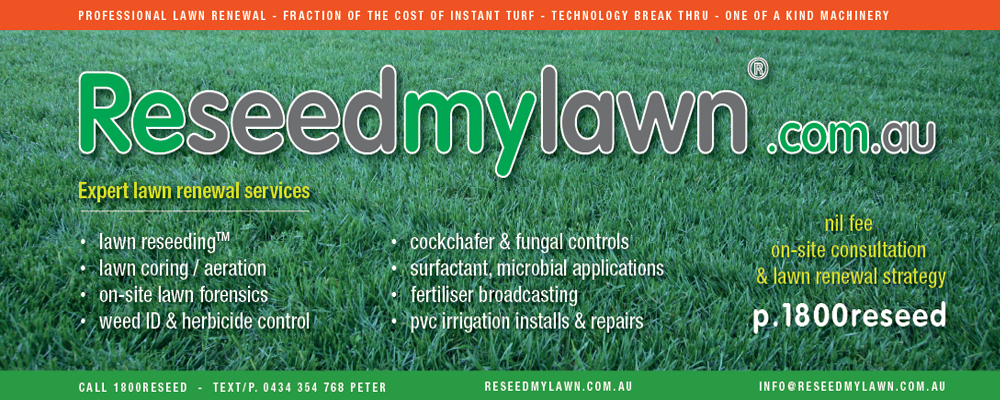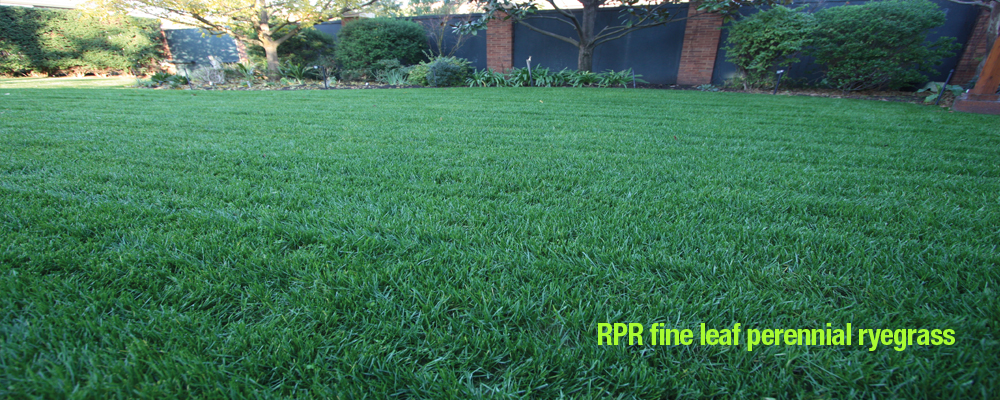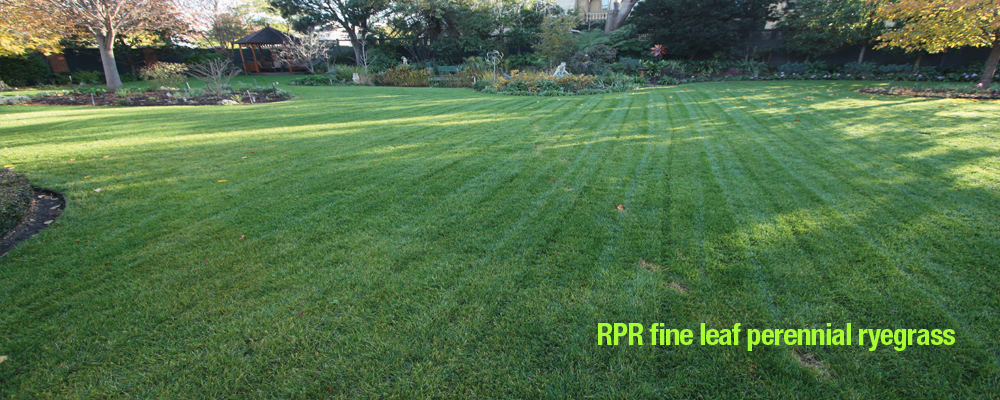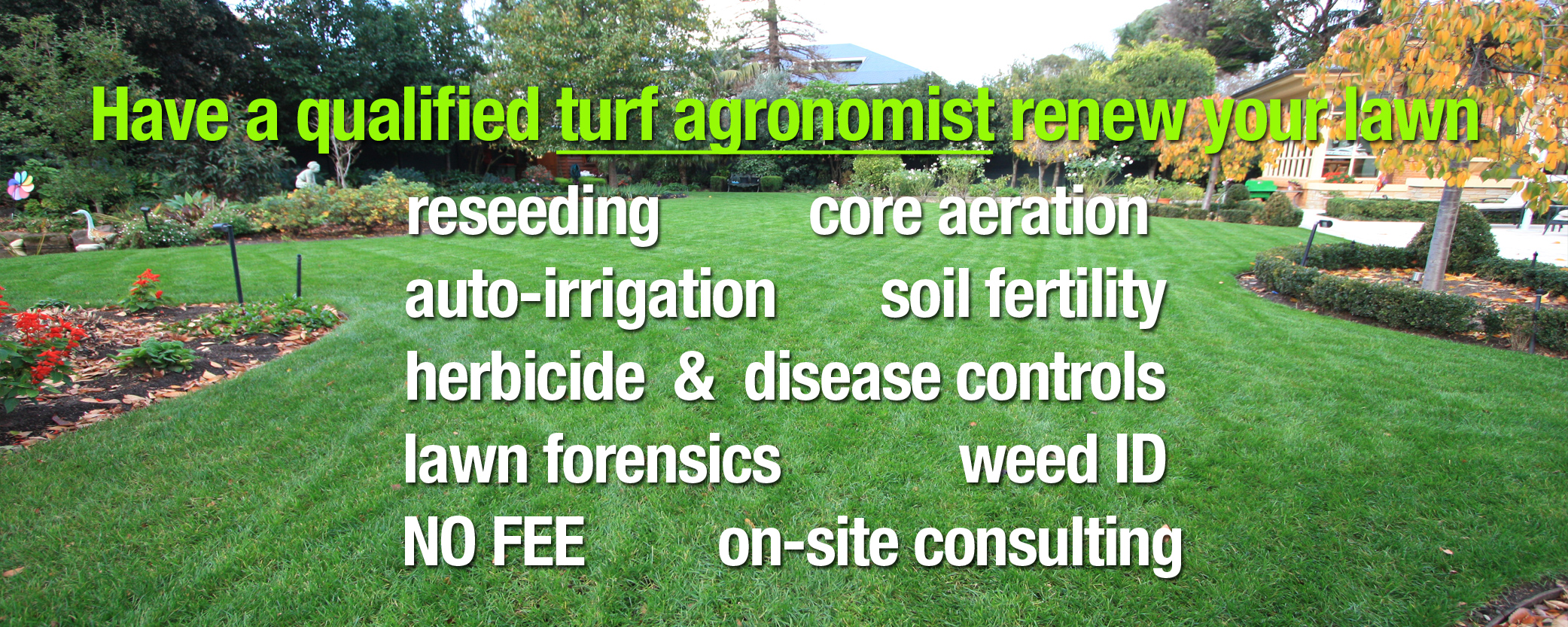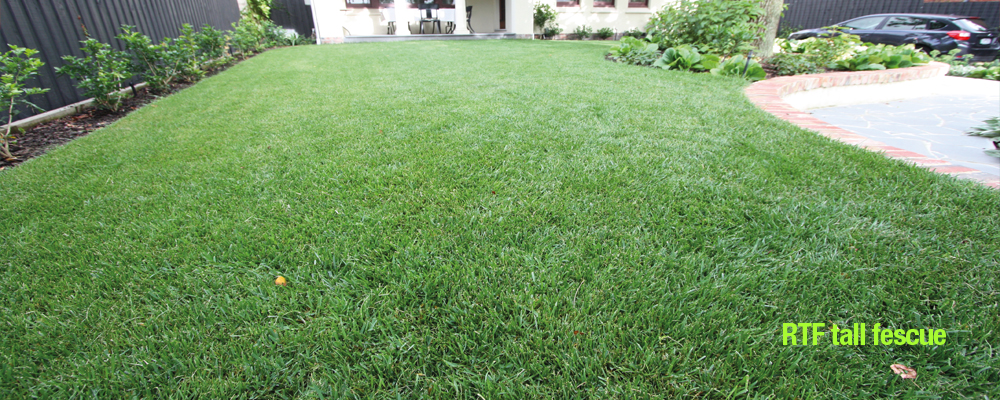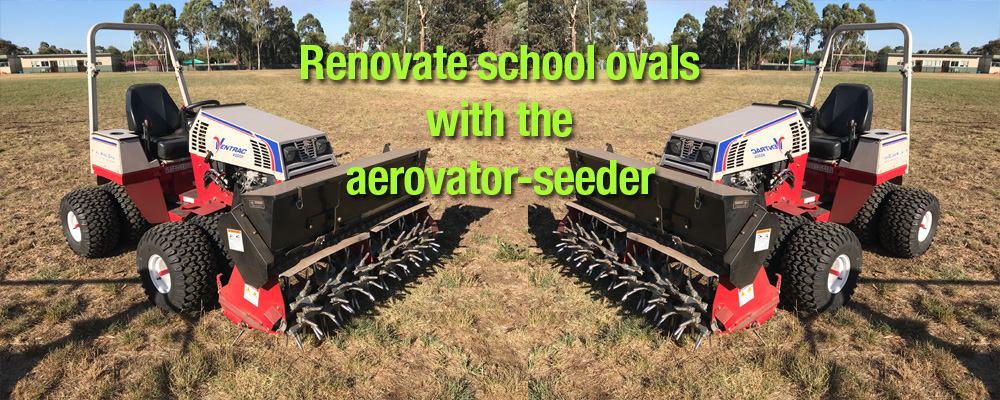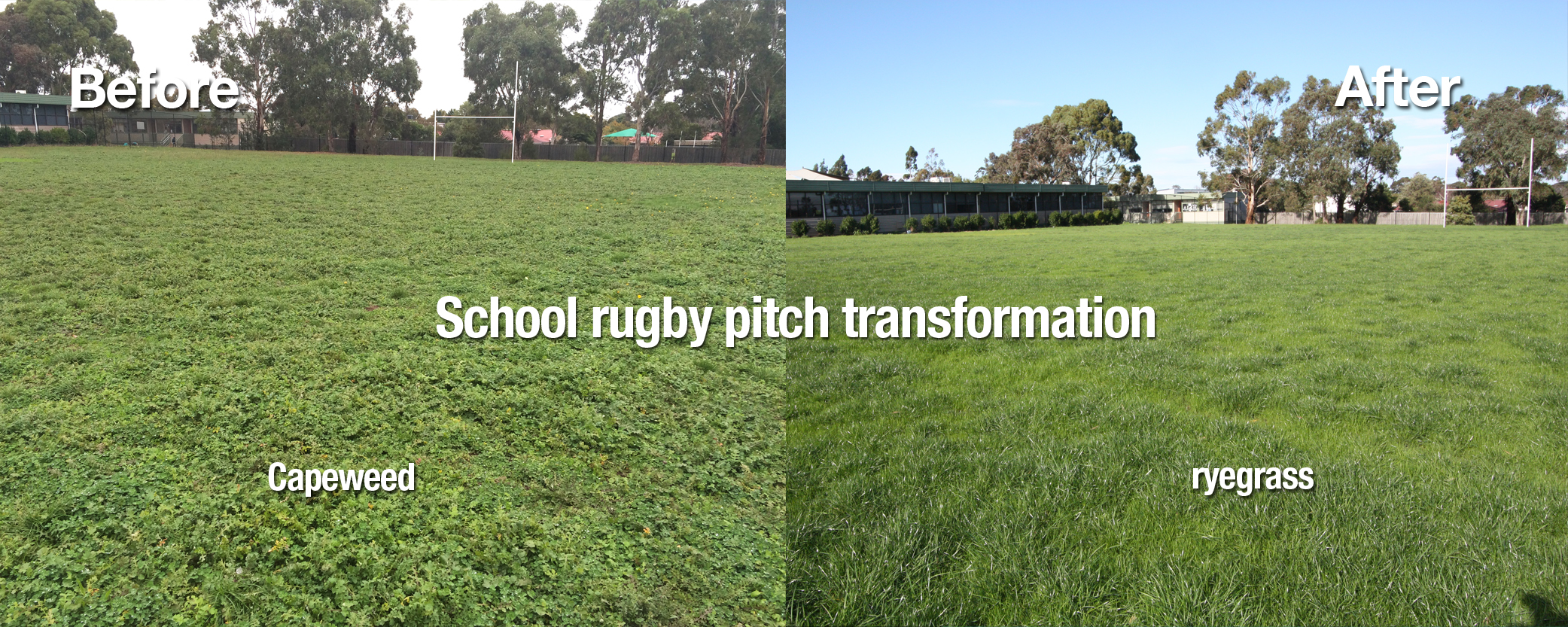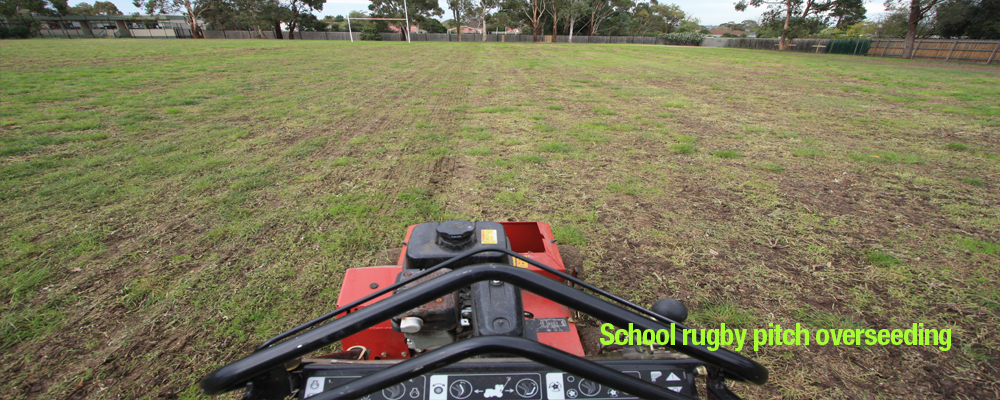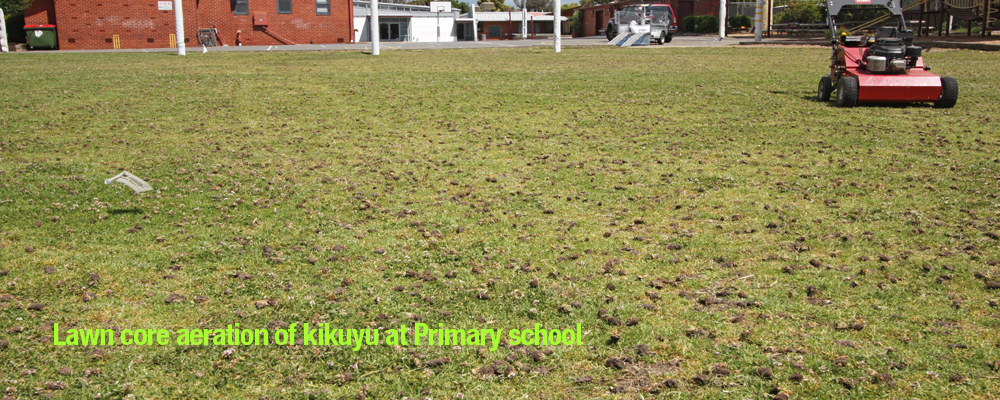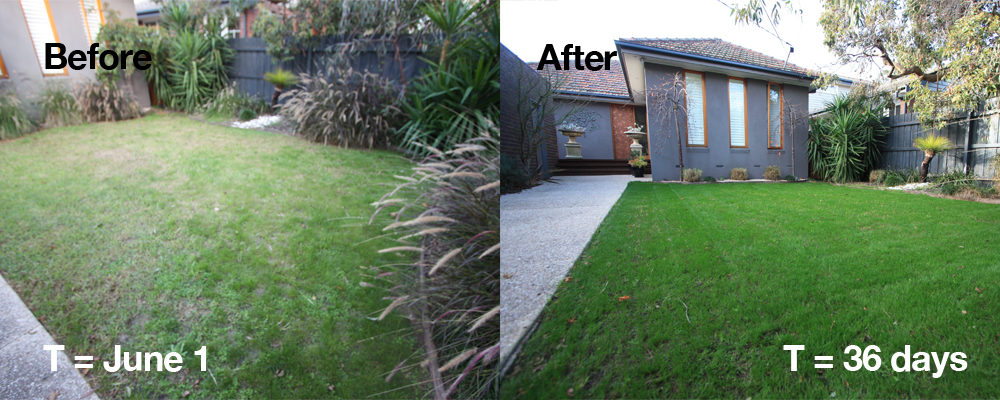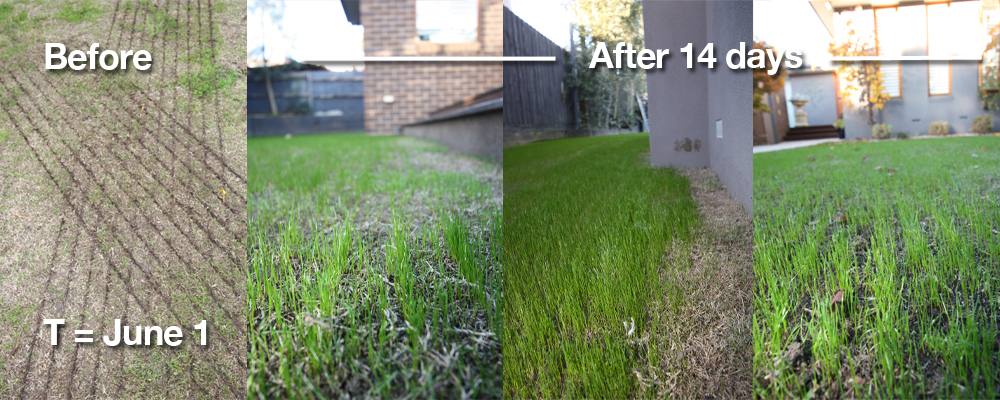
Free on-site consultation and lawn renewal strategy
Lawn reseeding
Our Turf reseeder™ accurately drills seed into and under existing lawn and bare ground for ideal seed-soil contact and seed wet-up, resulting in dense and uniform establishment. Vertical blades slice into existing lawn, creating a slice opening; depositing and securing seed at correct depth and rate, with minimal lawn disruption or soil tillage.
Our Turf reseeder™ machine is the only one of its kind, having engineered a precision seed delivery gate for accurate seed placement within the soil.
Lawn coring | lawn aeration
All lawns, including buffalo, kikuyu and couch can benefit from lawn coring. Hundreds of lawn cores or plugs are pulled from the lawn. Coring removes root thatch, relieves compaction and allows soil microbes and plant roots deep access to oxygen, water and applied nutrients. All lawns tend to flourish after lawn coring, benefiting from new root growth in a healthier root zone.
Onsite lawn forensic investigations
The heart of any lawn renewal strategy starts with an on-site forensic investigation. Our chief agronomist has 30 years of practiced field and turf agronomy experience working within the life science, turf seed and agricultural and turf industries.
- What is the householders objective for the lawn?
- What is the lawns aspect? What grass types can be supported?
- What grass types are present and percentage coverage?
- What weed types are present?
- What is the soil type, topography, limiting factors and remedy required?
- What are the limiting factors for grass growth? Soil nutrition, non-wetting sands, cockchafer grub, moss and algea, plant root and leaf diseases?
- What is the irrigation regime? Overwatering ?
- Presenting lawn renewal strategy – best options, where to from here, how and when
Weed control | weed identification | herbicide application
We are experts in weed identification, weed plant lifecycle, conditions for growth, competitive interactions and herbicide use.
We use a range of selective herbicides that are only available to the professional turf industry. We have control measures for Poa annua (winter grass) and a full range of broadleaf weeds including capeweed , wireweed, flatweed, bindii, plantain and clovers. We also have control measures for hard to kill weeds like Oxalis (soursob), marshmellow, and summer grasses such as digitaria (crab grass) and paspalum.
All herbicides are applied in compliance with the manufacturers registered label. We take every precaution and cross-check to ensure safe application.
Soil remediation | microbial inoculation | non wetting sands
For turf grass to thrive soil conditions need to be optimal for plant growth.
Sub optimal soil conditions for plant growth include:
- Non-wetting hydrophobic sands
- Very low organic matter (OM) content
- Excessive OM content (root thatch)
- Lawn grub | pathogen spore
- Low water holding capacity
- Low soil structure
- Low microbial activity for mineralization
- Defeciency in macro and trace elements
- Waterlogging | poor drainage
- Compaction | poor aeration
- Weed seed contamination
- Builders/painters works contamination
- Excessive soil pH
- Gravel and concrete
- Sodic or saline conditions
- Lack of topsoil
- Moss and algae growth
We have a range of machinery, remediation products and strategies to treat soil problems once identified. If required, we simply bring in clean topsoil and re-level and lightly roll to establish good growing conditions for plant growth.
Lawn grub | cockchafer | insect control
Lawn grub or orange headed cockchafer chewing out the roots of new grass can devastate lawns. Most lawn owners don’t reckonise its existence or the damage it does to plants. It is so prevalent, it’s the first forensic test we dig for. We consider ourselves experts in cockchafer detection, lifecycle identification and eradication strategies.
Below is a list of preconditions and our probability estimate of cockchafer infestation:
- Property is located in Boroondara, Bayside, Stonnington Glen Eira, Port Philip local government areas~ 35% likely
- Lawns are surrounded surrounded by deciduous leafy trees ~ 40% likely
- Have large deciduous leafy trees lining the street or near by~ 40% likely
- Have lawn irrigation~ 50% likely
- Have lawn irrigation and are prone to over watering~ 70% likely
- Have or see Black Beetle in the garden or on lawns, especially mid-September ~ 99% likely
- Have magpies, listening for grub movements then beaking for grubs~ 80% likely
- Find 8-10mm holes in lawn from magpies beaking for grubs~ 80% likely
- Have an evergreen lawn for Black Beetles to fly in and lay eggs~ 50% likely
- Have excessive thatch build up under moist soil conditions~ 50% likely
- Have the lawn opening up because of individual plant death~ 70% likely
- Grass plants easily “pulls” from the soil~ 70% likely
- Have denuded lawn areas 400-900 cm2 between plants~ 50% likely
- Find the lawn grub (cockchafer) in the garden bed surrounds~ 90% likely
- Find the lawn grub (cockchafer) and the adult black beetle simultaneously~ 95% likely
To eliminate lawn grub or orange headed cockchafer, you have to break its breeding lifecycle. Insecticides are effective when applied after the black beetle as converged on your lawn to lay eggs. It’s the eggs and early larvae that you need to target by applying an insecticide from late September. The insecticide to use is Acelepryn. It is a non scheduled insecticide so it is completely safe.
Reseedmylawn treat lawns for Lawn grub (orange headed cockchafer) with Acelepryn. Learn more about Acelepryn here.
Plant disease control | leaf and root diseases
As nature would have it, as animal microbes host off animals and humans (i.e. skin infections), the same is the case in the plant world. Turf grass is no different and plays host to range of bacterial and fungal pathogens. Healthy turf grass resists pathogens. However, when conditions are stressful for host turf grass and conducive for pathogen colonization, infection of the plant occurs, in the leaf, in the crown or within the roots.
Turf grass disease infection may develop when:
- There is a suspecible host plant
- Presence of disease causing pathogen
- Correct environmental conditions over a period of time
Managing the disease involves disrupting one or more of the above pre conditions. Cultural controls (management) to disrupt environmental conditions for the disease to develop will check the disease. This includes raising the mower height, balancing fertility, turning off the irrigation for a period, drying out the soil profile and grass canopy, and soil core aeration.
The other option is to remove the disease causing pathogen with a fungicide
The range of turf grass diseases include:
- Rhizotonia (Brown patch)
- Pythium leaf blight
- Pythium root rot
- Fusarium
- Grey leaf spot
- Red thread
- Pink patch
- Crown rust (Puccinia)
- Dreshlera leaf spot, crown rot, and root rot.
If we suspect a disease pathogen, we generally act by applying a broad-spectrum fungicide and advising the lawn owner to change management conditions and monitor. Almost always, the turfgrass grows out of the disease back to full health.
Invariably, turfgrass species carry genes for disease resistance bred into them making them less susceptible to pathogen attack.
Newer turfgrass species also carry a beneficial symbiotic fungus called Endophyte. The endophyte co-exists in the turfgrass roots secreting alkaloids that deter some root feeding insects.
Algae and moss in lawns
Moss and algae can develop in your lawn with the following preconditions:
- Area is fully shaded receiving only referred light
- North facing areas fully shaded by trees or fence
- Soil profile is permanently saturated from an underground soak
- Soil profile is substantially ‘lower’ then surrounding profile.
- Soil is compacted and with poor drainage
- Winter cool wet ambient conditions
- Poor soil aeration (anaerobic microbial conditions)
- OVERWATERING from auto irrigation
Overwhelmingly the cause of rampant algae and moss growth why we see in Melbourne’s southeast is OVERWATERING. Invariably, the householder has not dialed back the lawns watering requirement on the auto controller. For the winter months the Auto irrigation controller should be off, perhaps a manual watering once in a while.
To put it perspective, the Evapotranspiration rate in winter is one–sixth of that in summer, turfgrass is in the low ebb of growth and we are generally inundated with showers through winter. Considering these factors, you need to manage against growing moss.
To get rid of moss, here’s what to do
- Change your management practice to the preconditions above. Turn you irrigation controller off for winter.
- Rake out the moss vigorously, north south, then east west
- Apply iron sulphate, either granular or in solution.
- Repeat weeks later as necessary
The moss should turn black and shrivel up
Note: Iron sulphate will stain concrete and tiles. Clean up with a blower vac or hose following application.
Lawn nutrition | turf fertilizer applications
Dollar for dollar, fertilization does more to improve poor-quality turfgrass or to maintain good-quality turfgrass than any other management practice.
Turfgrasses require at least 16 nutrients for normal growth and development. Some nutrients are needed in large amounts, other nutrients only in minute quantities.
Nitrogen, phosphorus, and potassium are referred to as primary nutrients and must be supplied periodically to turf through fertilizer applications. Calcium, magnesium, and sulfur, the secondary nutrients, are needed only occasionally in the form of fertilizer or lime.
The micronutrients iron, manganese, zinc, boron, copper, molybdenum, and chlorine are required only in minute amounts and are rarely supplied to turfgrasses through fertilization.
Exceptions are if turfgrasses are planted on high-sand-content soils, such as Melbourne’s sand belt
Deficiencies can also appear as a thinning of the stand, stunted growth, and increased susceptibility to disease.
Reseedmylawn have a range of inorganic, organic and foliar fertilisers containing macro and mirco nutrients. We are regularly engaged to fertilise school sportsgrounds, home lawns, public and private green space. We are able to recommend the most appropriate fertiliser based on a number of agronomic variables, including budget.
All reseeded lawn receive complete slow release organic base fertiliser along with capital phosphorus and nitrogen. Reseeded lawn are followed up with strategic nitrogen applications.
Nitrogen
Nitrogen is an essential element for all living things and the mineral element needed in the largest amounts by turfgrasses. It is in limited supply in soils and available to plants only after it has been converted to nitrate (NO 3 – )or ammonium (NH 4 + ) by microorganisms or industrial processes (fertiliser). Both forms are highly polar molecules and adhere to the polar ends of the water molecule. As such where water goes, so does nitrogen, particularly nitrate. As such, nitrogen is easily leached from the profile and needs to be reapplied. One solution is slow release N fertilisers or organic forms that have to be broken down by microbes. In most cases, nitrogen fertilizer must be applied regularly to maintain high quality turf.
In Melbourne’s sandbelt Nitrogen defeciency is the single most limiting factor for turfgrass growth and vigor. Application of N should be made considering the time of year, watering regime, turgrass growth lifecycle, soil texture (clay or sand), the fertiliser type and other. Rule of thumb is to “grow grass when grass grows”.
For the warm season grasses, apply nitrogen periodically from October thru to April with irrigation. For the cool season grasses, apply when the grasses are actively growing- more frequent in autumn and spring, less frequent in winter and summer.
A good visual test for Nitrogen deficiency is a distinct yellowing of the leaf tips in the older most leaf blades. Turfgrass plant self consume nitrogen within the older leaf blade to support the youngest emerged leaf blade.
Phosphorus
Phosphorus is extremely important for rooting, seedling development, cell division, cellular energy interaction and the synthesis of various compounds used by plants.
Phosphorus deficiencies in turf are usually expressed in the early stages of seedling development, appearing as a purple or red coloring of leaf blades and as reduced growth and tillering.
Phosphorus is largely immobile in soils—meaning that it takes a long time to move from the turf surface into the root zone. Phosphorus may take weeks or months to move just a few centmetres in soil. Because of its poor mobility, phosphorus should be incorporated into the soil prior to seeding or sodding.











